Module 4 Unit 2 Wind 课件(共81张PPT)
文档属性
| 名称 | Module 4 Unit 2 Wind 课件(共81张PPT) | 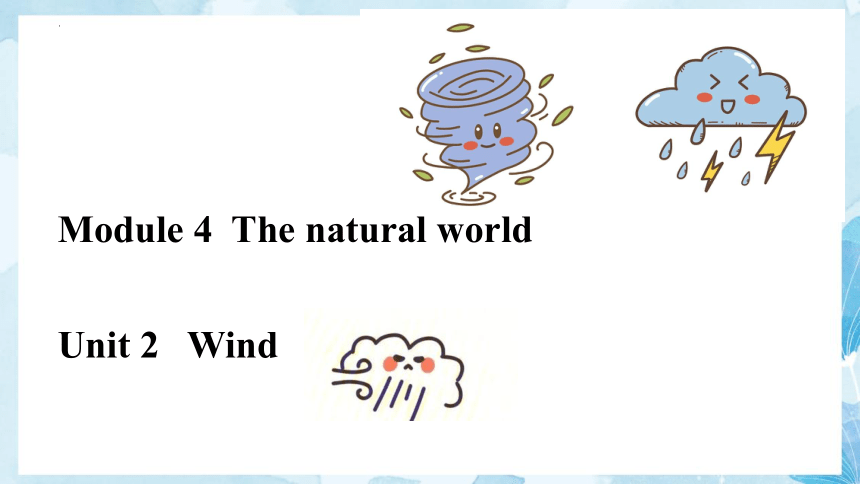 | |
| 格式 | pptx | ||
| 文件大小 | 14.1MB | ||
| 资源类型 | 试卷 | ||
| 版本资源 | 牛津上海版(试用本) | ||
| 科目 | 英语 | ||
| 更新时间 | 2023-12-06 21:06:41 | ||
图片预览

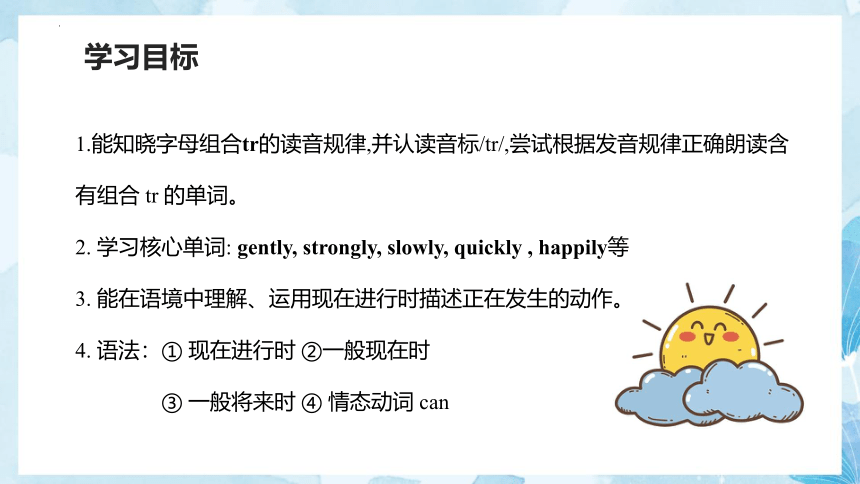
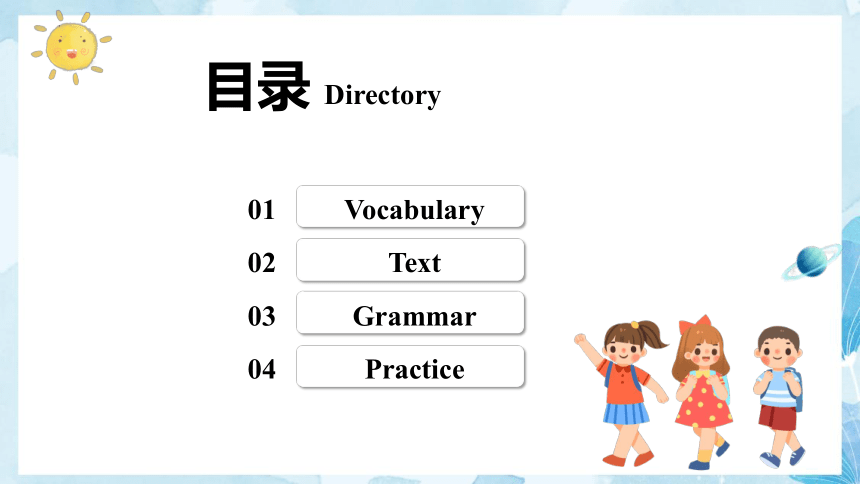

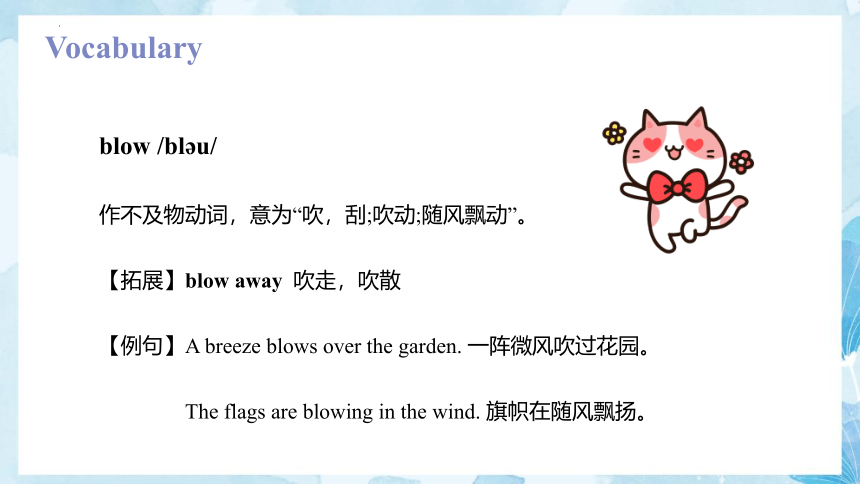
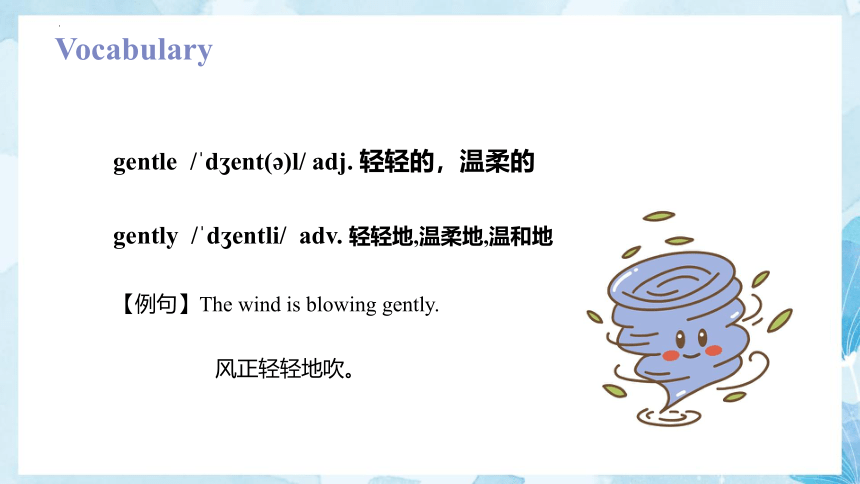
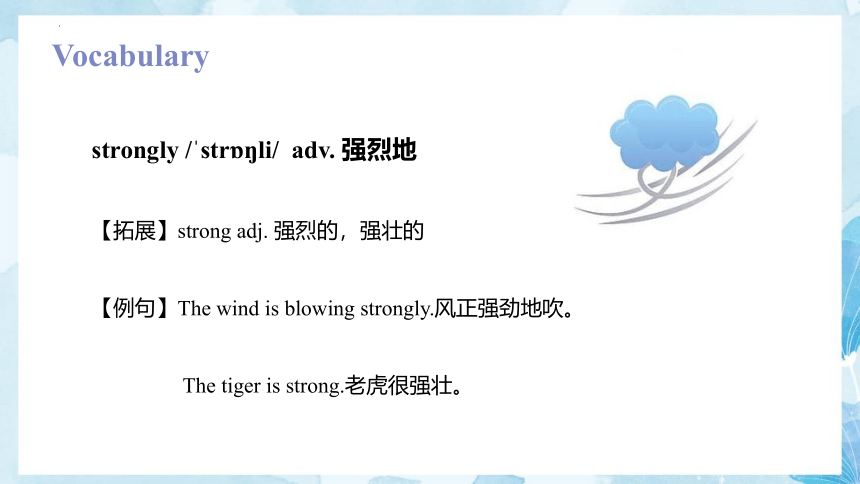
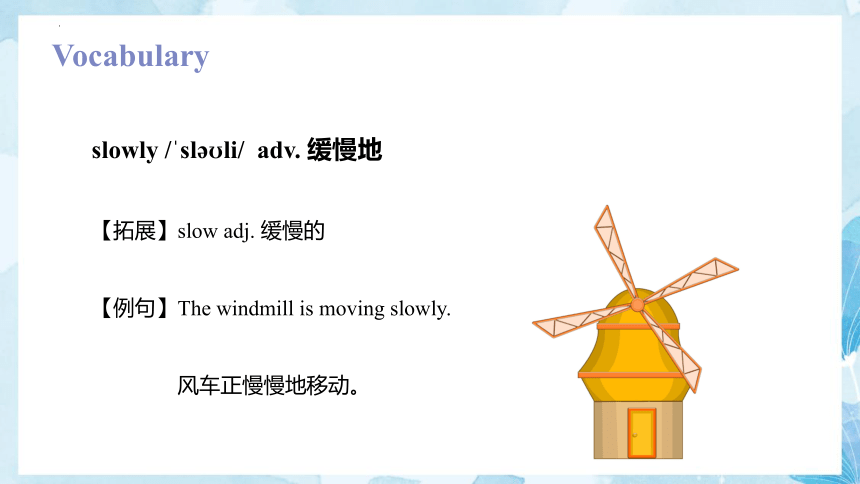
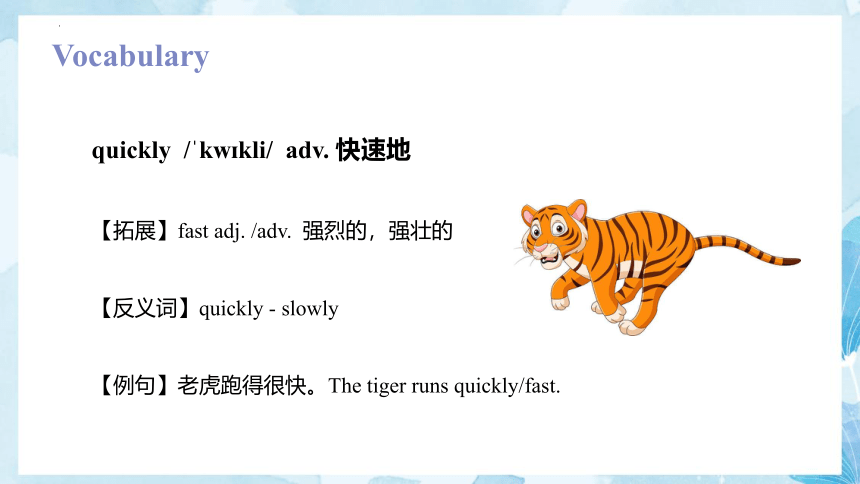
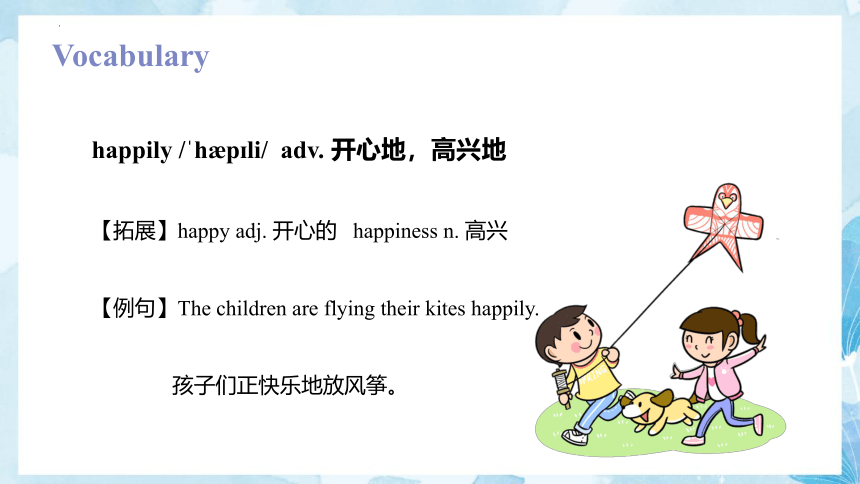
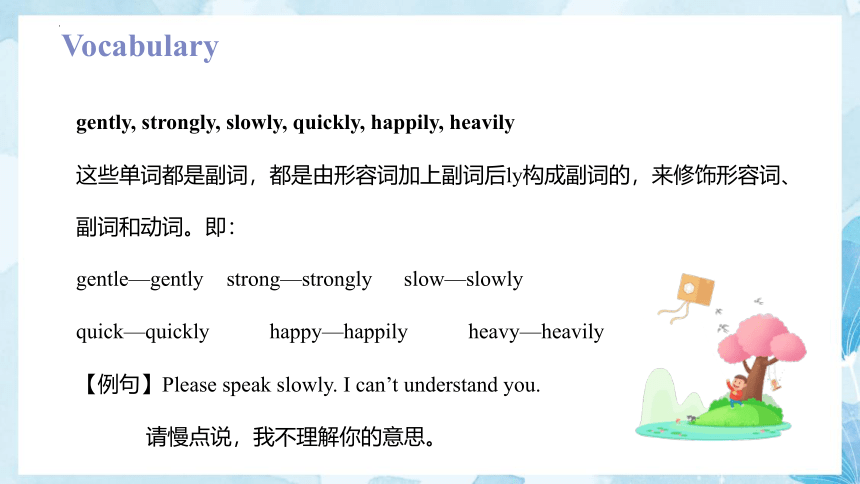
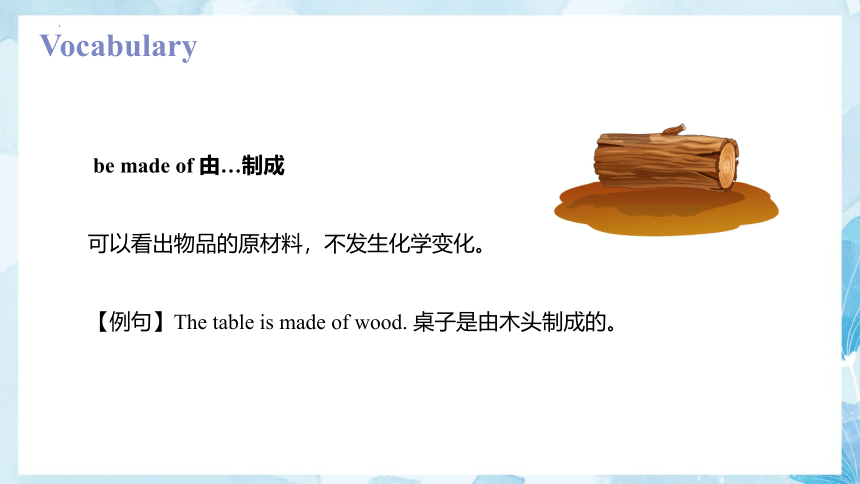
文档简介
(共81张PPT)
Module 4 The natural world
Unit 2 Wind
学习目标
1.能知晓字母组合tr的读音规律,并认读音标/tr/,尝试根据发音规律正确朗读含有组合 tr 的单词。
2. 学习核心单词: gently, strongly, slowly, quickly , happily等
3. 能在语境中理解、运用现在进行时描述正在发生的动作。
4. 语法:① 现在进行时 ②一般现在时
③ 一般将来时 ④ 情态动词 can
01
Vocabulary
02
Text
03
Grammar
04
Practice
目录 Directory
行业PPT模板http:///hangye/
PART 01
Vocabulary
blow /bl u/
作不及物动词,意为“吹,刮;吹动;随风飘动”。
【拓展】blow away 吹走,吹散
【例句】A breeze blows over the garden. 一阵微风吹过花园。
The flags are blowing in the wind. 旗帜在随风飘扬。
Vocabulary
Vocabulary
gentle / d ent( )l/ adj. 轻轻的,温柔的
gently / d entli/ adv. 轻轻地,温柔地,温和地
【例句】The wind is blowing gently.
风正轻轻地吹。
strongly / str li/ adv. 强烈地
【拓展】strong adj. 强烈的,强壮的
【例句】The wind is blowing strongly.风正强劲地吹。
The tiger is strong.老虎很强壮。
Vocabulary
slowly / sl li/ adv. 缓慢地
【拓展】slow adj. 缓慢的
【例句】The windmill is moving slowly.
风车正慢慢地移动。
Vocabulary
quickly / kw kli/ adv. 快速地
【拓展】fast adj. /adv. 强烈的,强壮的
【反义词】quickly - slowly
【例句】老虎跑得很快。The tiger runs quickly/fast.
Vocabulary
happily / h p li/ adv. 开心地,高兴地
【拓展】happy adj. 开心的 happiness n. 高兴
【例句】The children are flying their kites happily.
孩子们正快乐地放风筝。
Vocabulary
Vocabulary
gently, strongly, slowly, quickly, happily, heavily
这些单词都是副词,都是由形容词加上副词后ly构成副词的,来修饰形容词、副词和动词。即:
gentle—gently strong—strongly slow—slowly
quick—quickly happy—happily heavy—heavily
【例句】Please speak slowly. I can’t understand you.
请慢点说,我不理解你的意思。
be made of 由…制成
可以看出物品的原材料,不发生化学变化。
【例句】The table is made of wood. 桌子是由木头制成的。
Vocabulary
be made of 由…制成
【拓展延伸】注意它和be made from, be made in等的区别。
be made from 由…制成,指“看不出物品的原材料”。
be made in 在/由…制造
【例句】The wine is made from grapes. 这酒是由葡萄制成的。
The watch is made in China. 这块表是在中国制造的。
Vocabulary
Vocabulary
1.in the wind 在风里
2.go out 出去
3. look out of the window 看向窗外
4.be made of wood 由木头做成
Vocabulary
5.draw a circle 画个圈
6.cut it out 剪下来
7.cut along them 沿着他们剪下
8. pin …to… 把…钉在…上
gently/ d entli/ adv. 轻轻地 strongly / str li/adv. 猛烈地
slowly/ sl li/ adv. 慢慢地 quickly / kw kli/ adv. 快地
blow /bl u/ v. 吹 happily / h p li/ adv. 开心地
Vocabulary
PART 02
Text
Listen and say
It blows gently.
The wind blows.
It blows gently.
The flowers dance in the wind softly.
The wind blows.
It blows strongly.
The children fly their kites happily.
吹地温柔
Listen and say
It blows gently.
The wind blows.
Sometimes it blows gently,
And the windmill moves slowly.
Sometimes it blows strongly,
And the windmill moves quickly.
Look and learn
gently strongly slowly quickly
温柔地 强烈地 缓慢地 快速地
Think and write
Think and write
Say and act
Ben: Mum, can we go out now
Mum: I'm afraid you can't. Look out of the window. It's raining heavily.
Ben: Oh, the wind is blowing strongly too.
Kitty: When can we go out and play
Mum: Let's watch the weather on TV.
出去
朝窗外看
下暴雨
看天气预报
Say and act
Weatherman: We have some heavy rain and a strong wind today.
But tomorrow will be a fine day.
Kitty: That's great! I can go to the park with Alice tomorrow.
Ben: And I can go and play football!
有大雨和大风。
太棒了!
去公园
踢足球
Read a story
The sound of the wind
Little Monkey has a wind-bell on his door. It is made of wood.
小猴子的门上有一个风铃。它是木头做的。
Read a story
The sound of the wind
Little Duck has a glass wind-bell on her window.
小鸭子的门上有一个玻璃风铃。
Read a story
The sound of the wind
Little Rabbit has some small bells in her room.
小兔子的房间里有一些小铃铛。
Read a story
The sound of the wind
Little Pig wants to hear the sound of the wind too.
小猪也想听到风声。
Read a story
The sound of the wind
Little Pig is making a wind-bell. He cuts the paper and makes a paper wind-bell.
小猪在做风铃。他把纸剪开,做了一个纸风铃。
Read a story
The sound of the wind
The wind blows gently. Little Pig hears the sound of the wind. But he does not like it.
风轻轻地吹着。小猪听到了风声。但是他不喜欢它。
Say and act
Answer the questions
1. What do Little Monkey, Little Duck and Little Rabbit hear
2. Why does Little Pig not like the sound of the wind
Make a windmill
Draw a circle and cut it out.
Draw eight lines and cut along them.
Make a windmill
Fold as a windmill.
Pin it to a pencil or a stick.
Learn the sounds
PART 03
Grammar
副词
副词通常用来修饰动词:
It blows gently. The flowers dance in the wind softly.
形容词变副词规律:
(1)在形容词词尾直接加-ly
如:real-really careful-carefully slow-slowly
quick-quickly quiet-quietly
(2)以辅音字母加y结尾的形容词要去y,然后再加-ily
如:busy-busily angry-angrily easy-easily happy-happily
(3)某些以辅音字母加不发音的e结尾和以-ue结尾的形容词要先去掉e,然后再加-y或-ly
如: terrible-terribly true-truly gentle-gently
(4)特殊变化:good---well
(5)形容词和副词一致:early, fast, much, little等
2.一般将来时
表示:将来某一时刻发生的动作和状态。
关键词:tomorrow, next week, in the future...
结构:主语+ will/ shall(第一人称) +动词原形
主语+ be+ going to + 动词原形
(这种结构通常表示计划、决定要做的事)
e.g. But tomorrow will be a fine day.
I am going to have a picnic with my friends tomorrow.
一般现在时
(1)经常性或习惯性的动作,常与表示频率的时间状语连用。
如:every year, sometimes, at 5 o'clock, on Sunday。
【例句】I get up at six o'clock every day. 我每天6点起床。
She smokes too much. 她抽很多烟。
I telephone to my parents once a week.
我一周给我父母打一次电话。
(2)表达客观真理,科学事实。如果出现在宾语从句中,即使主句是过去时,从句谓语也要用一般现在时。
【例句】Three and four makes seven.三加四等于七。
The teacher told us that the earth moves around the sun.
老师告诉我们地球绕着太阳转。
Shenyang lies in the north of China. 沈阳位于中国北部。
一般现在时
基本概念
表示经常发生的事情,动作或存在的状态。
时间标志
always, usually , often , sometimes ,every…
一般现在时
构成及变化
1.be动词的变化。
肯定句:主语+be(am, is, are)+其它。
如: I am a boy.
否定句:主语+ be + not +其它。
如:He is not a worker.
一般现在时
行为动词的变化。
① 当主语为第一,二人称及复数时,助动词为do
肯定句:主语+动词原形(+其它)。
如:We often play basketball after school.
否定句:主语+ don't+动词原形(+其它)。
如:We don’t play basketball after school.
行为动词的变化。
② 当主语为第三人称单数时, 助动词为does
肯定句:主语+动词三单式(+其它)。
如: He swims well.
否定句:主语+ doesn’t+动词原形(+其它)。
如:He doesn’t swim well..
第三人称单数的动词变化规则(只有在第三人称为主语的肯定句中,动词才用三单式)
(1) 多数动词直接加s:
runs gets likes collets takes plays climbs…….
(2) 结尾是s, x, sh, ch, o,前为辅音字母,
结尾加es : watches teaches goes does washes crosses mixes brushes
(3) 动词末尾y前为辅音:
将y改为i加es: study→studies fly→flies carry→carries cry→cries
但在y前如果为元音则直接加s: buys says
现在进行时
(1) 现在进行时由“be+v-ing”构成。
be为助动词,它应与主语的人称和数保持一致。
现在进行时
肯 定 句 否 定 句
I am working. I am not working.
You are working. You are not working.
He/She/It is working. He/She/It is not working.
We/You/They are working. We/You/They are not working.
疑 问 句 简 略 答 语
Am I working Yes, you are.
No, you are not.
Are we working Yes, we/ you are.
No, we/ you aren’t.
Are you working Yes, I am.
No, I am not.
Yes, we are.
No, we are not.
Is he/she it working Yes, he/she/it is.
No, he/she/it is not.
Are they working Yes, they are.
No, they are not.
现在进行时
(2)现在进行时的应用。在实际应用时,现在进行时常有以下几种情况:
①当句子中有now时,常表示动作正在进行,这时要用现在进行时。
【例句】They are playing basketball now. 现在他们正在打篮球。
②以look,listen开头的句子,提示我们动作正在进行,这时要用现在进行时。
【例句】Listen! She is singing an English song. 听,她正在唱英语歌。
③表示当前一段时间或现阶段正在进行的动作,且此时有this week, these days等时间状语,这时常用现在进行时。
【例句】 We are making model planes these days.
这些天我们在做飞机模型。
④描述图片中的人物的动作,也为了表达更生动。此时也常用现在进行时。
【例句】Look at the picture. The children are flying kites in the park.
看这幅图,那些孩子正在公园放风筝。
现在分词-ing变化规则1. 一般在动词原形末尾加-ing。 stay --- staying do --- doing listen --- listening2. 以不发音的字母e 结尾的动词,先去掉e,再加-ing。 make --- making ride --- riding give --- giving
现在分词-ing变化规则3. 以一个辅音字母结尾的重读闭音节词,先双写这个辅音字母,再加-ing。 put --- putting sit --- sitting run --- running4. 以ie 为重读音节结尾的单词,先去掉e,把i 变为y,再加 –ing。 lie --- lying die --- dying
现在进行时的用法1. 表示现在或说话时正在进行的动作,常和下列时间状语连用:now, at this moment, at present, these days (years), this term … 有时也与look , listen 等连用。 例句:Look, what are the monkeys eating 看,那些猴子在吃什么?2. 表示当前一直或反复在进行的动作或难以终止的动作。 例句:They are running and jumping all the time. 他们一直在跑啊跳啊。
构词法
有些形容词加上副词后缀-ly构成副词,如本课出现的gently,strongly, slowly, quickly, happily, heavily等。
【例句】He is very strong(adj.). 他很强壮。
It blows strongly (adv.). 风刮得很大。
情态动词can(用法:can + 动词原形)
可以用来征询对方是否同意。
【例句】Can I go out for a walk
我可以出去散步吗?
PART 04
Sentences
1. There's no wind.没有风。
no = not a/not any
【例句】They have no brother or sister. 他们没有兄弟姐妹。
I have no pen to use. 我没有可用的钢笔了。
2. I’m afraid you can’t. 恐怕你不能。
本句看起来很简短,实际上这是一个含有宾语从句的主从复合句。
you can't作afraid的宾语。
【例句】I’m afraid I can't go with you. 恐怕我不能和你一起去了。
I'm afraid you must stay at home. 恐怕你必须留在家里。
【拓展延伸】用afraid作简略回答,应为I'm afraid so. / I'm afraid not.
【例句】—Mum, can I go out to play 妈妈,我能出去玩吗?
—I'm afraid not.恐怕不行。
批注:可以拓展一下afraid 的其他用法。
1.be afraid of sth. 害怕某人或某物
I am afraid of snake.
2.be afraid to do sth的意思是:害怕做某事或不敢做某事。
如:He was afraid to fly in a plane.
他不敢坐飞机。
3. I want to hear it too. 我也想听到风声。
hear意为“听到”,强调听的结果,而与之对应的listen to则强调听的过程。
【例句】I am listening to music. 我在听音乐。
Do you hear someone singing a song in the next room
你听见有人在隔壁唱歌吗?
批注:可以拓展一下其他相似的词组:look for与find;
find 和 look for 都有“找”的意思,但含义不同。
find 强调“找”的结果,而look for 强调“找”的过程。
请看下列例句:
He is looking for his bike. 他在找他的自行车。
I’m looking for my watch, but can’t find it. 我在找我的手表,但是找不到。
PART 05
Practice
Read and choose(语音判断,将发音不同的单词的编号写在前面的括号内)( ) 1. A. find B. hide C. five D. give( ) 2. A. potato B. cocoon C. clock D. carrot( ) 3. A. this B. those C. thank D. with( ) 4. A. light B. rice C. radio D. Write
Fill in the blanks with given words in their proper forms
(用所给单词的适当形式填空)1. There is (uniform) on the bed. It's for (he).2. That (boy) plums are very sour.3. Look, the (cook) are working hard in the kitchen.4. —What weather do you like, Farmer Hong —I like the (rain) days.
Fill in the blanks with given words in their proper forms
(用所给单词的适当形式填空)5. It's ten o'clock. Mr. Smith and his students (not be) in the classroom. They (plant) trees in the playground.6. Today is Kitty's birthday. She wants (buy) some balloons.
Choose the best answer (选择最佳答案,将字母代号写在前面的括号内)( )1. I have one-yuan note. Where is note I can't find it.A. an; the B. a; the C. a; a( )2. The can eat the leaves on the .A. giraves; roofs B. giraffes; rooves C. giraffes; roofs( )3. Let's the weather TV.A. watching; on B. watch; on C. watch; from
( )4. The twins often go Grandma Wang's home.A. to B. / C. for( )5. Look out of the window. It's raining .A. heavy B. heavily C. hardly( )6. It is summer. It is too hot in the room.A. on B. in C. /
( )7. — are the children sitting on —On the sofa.A. Where B. What C. Which( )8. The block's shadow is not at a quarter to twelve in the morning.A. long B. short C. tall
( )9. There are floors in our block. We live on floor.A. twelve; twelfth B. twelve; the twelveth C. twelve; the twelfth( )10. Wow, so many people at the party this evening. There are about five in all.A. hundreds B. hundred C. hundreds of( )11. The new shop is going to open the morning October 10th.A. in; of B. at; of C. on; of
Rewrite the following sentences (改变句子,每空格一词)1. John's brother has lunch at school every day. (改为一般疑问句) John's brother lunch at school every day 2. The girls like singing and dancing. (改为否定句) The girls like singing dancing.3. It's warm and wet in spring in Shanghai. (就画线部分提问) is the in spring in Shanghai
Rewrite the following sentences (改变句子,每空格一词)4. Our maths teacher buys her daughter a yellow parrot. (换种表达,意思不变)Our maths teacher a yellow parrot her daughter.5. The children fly kites happily in the park. (就画线部分提问) the children fly kites in the park
用下列单词的适当形式填空。
1.We often___________ (play) in the playground.
2. He ___________ (get) up at six o’clock.
3. Danny ___________ (study) English, Chinese, Maths, Science and Art at school.
4. Mike sometimes ___________ (go) to the park with his sister.
用下列单词的适当形式填空。
5. I like ____________ (swim).
6. He _________(read) English every day.
7. We _________(go)to school at seven in the morning.
8. My mother________(like) ______(go) shopping.
将日期与节日配对。 A ( ) 1. January 1st A. Children’s Day( ) 2. March 8th B. New Year’s Day( ) 3. June 1st C. Teachers’ Day( ) 4. October 1st D. Women’s Day( ) 5. September 10th E. National Day
B( ) 1. On the 4th Thursday of November A. Easter( ) 2. On the 2nd Sunday in May B. Halloween( ) 3. On the 25th of December C. Mother’s Day( ) 4. On the 31st of October D. Christmas( ) 5. On a Sunday in March or April E. Thanksgiving
找出与划线部分意思相近的词语或句子。( ) 1. Mum, can I have some pumpkin pies A. A. Eat B. drink C. want( ) 2. What can I do for you A. A. Can you help me B. Can I help you C. I can help you.( ) 3. There’s the e on.A. A. There’s a bell. B. You can see the bell.
C. The bell is ringing.
( ) 4. There is a little milk in the bottle.
A. There is no milk in the bottle. B. There is much milk in the bottle.
C. There is not much milk in the bottle.
( ) 5. The English boy can speak a little Chinese.
A. The English boy doesn’t like Chinese. B. The English boy often speaks Chinese.
C. The English boy can speak some Chinese.
Read and choose(阅读短文,选择最佳答案,将字母代号写在括号内) It’s the first day of school. Tom wants to go back to school. He wants to see his friends. He wants to meet his new teacher. Tom gets up early in the morning. He washes and eats his breakfast. Then he rides his bike to school. He sees his friends in the playground. He plays hide-and-seek with them. In the classroom, Tom meets his new English teacher. Her name is Mrs Green. Tom likes Mrs Green. She can speak English very well. He thinks she is a nice teacher.
( ) 1. Does Tom wash and eat breakfast in the morning
A. Yes, he is. B. Yes, he does. C. No, he doesn’t.
( ) 2. Mrs Green is __________________.
A. Tom’s mother B. Tom’s Chinese teacher C. Tom’s English teacher
( ) 3. Tom plays _____________ with his friends.
A. football B. basketball C. hide-and-seek
( ) 4. Where does Tom meet his new teacher ________
A. In the playground. B. In the classroom. C. Under the tree.
Thank you!
Module 4 The natural world
Unit 2 Wind
学习目标
1.能知晓字母组合tr的读音规律,并认读音标/tr/,尝试根据发音规律正确朗读含有组合 tr 的单词。
2. 学习核心单词: gently, strongly, slowly, quickly , happily等
3. 能在语境中理解、运用现在进行时描述正在发生的动作。
4. 语法:① 现在进行时 ②一般现在时
③ 一般将来时 ④ 情态动词 can
01
Vocabulary
02
Text
03
Grammar
04
Practice
目录 Directory
行业PPT模板http:///hangye/
PART 01
Vocabulary
blow /bl u/
作不及物动词,意为“吹,刮;吹动;随风飘动”。
【拓展】blow away 吹走,吹散
【例句】A breeze blows over the garden. 一阵微风吹过花园。
The flags are blowing in the wind. 旗帜在随风飘扬。
Vocabulary
Vocabulary
gentle / d ent( )l/ adj. 轻轻的,温柔的
gently / d entli/ adv. 轻轻地,温柔地,温和地
【例句】The wind is blowing gently.
风正轻轻地吹。
strongly / str li/ adv. 强烈地
【拓展】strong adj. 强烈的,强壮的
【例句】The wind is blowing strongly.风正强劲地吹。
The tiger is strong.老虎很强壮。
Vocabulary
slowly / sl li/ adv. 缓慢地
【拓展】slow adj. 缓慢的
【例句】The windmill is moving slowly.
风车正慢慢地移动。
Vocabulary
quickly / kw kli/ adv. 快速地
【拓展】fast adj. /adv. 强烈的,强壮的
【反义词】quickly - slowly
【例句】老虎跑得很快。The tiger runs quickly/fast.
Vocabulary
happily / h p li/ adv. 开心地,高兴地
【拓展】happy adj. 开心的 happiness n. 高兴
【例句】The children are flying their kites happily.
孩子们正快乐地放风筝。
Vocabulary
Vocabulary
gently, strongly, slowly, quickly, happily, heavily
这些单词都是副词,都是由形容词加上副词后ly构成副词的,来修饰形容词、副词和动词。即:
gentle—gently strong—strongly slow—slowly
quick—quickly happy—happily heavy—heavily
【例句】Please speak slowly. I can’t understand you.
请慢点说,我不理解你的意思。
be made of 由…制成
可以看出物品的原材料,不发生化学变化。
【例句】The table is made of wood. 桌子是由木头制成的。
Vocabulary
be made of 由…制成
【拓展延伸】注意它和be made from, be made in等的区别。
be made from 由…制成,指“看不出物品的原材料”。
be made in 在/由…制造
【例句】The wine is made from grapes. 这酒是由葡萄制成的。
The watch is made in China. 这块表是在中国制造的。
Vocabulary
Vocabulary
1.in the wind 在风里
2.go out 出去
3. look out of the window 看向窗外
4.be made of wood 由木头做成
Vocabulary
5.draw a circle 画个圈
6.cut it out 剪下来
7.cut along them 沿着他们剪下
8. pin …to… 把…钉在…上
gently/ d entli/ adv. 轻轻地 strongly / str li/adv. 猛烈地
slowly/ sl li/ adv. 慢慢地 quickly / kw kli/ adv. 快地
blow /bl u/ v. 吹 happily / h p li/ adv. 开心地
Vocabulary
PART 02
Text
Listen and say
It blows gently.
The wind blows.
It blows gently.
The flowers dance in the wind softly.
The wind blows.
It blows strongly.
The children fly their kites happily.
吹地温柔
Listen and say
It blows gently.
The wind blows.
Sometimes it blows gently,
And the windmill moves slowly.
Sometimes it blows strongly,
And the windmill moves quickly.
Look and learn
gently strongly slowly quickly
温柔地 强烈地 缓慢地 快速地
Think and write
Think and write
Say and act
Ben: Mum, can we go out now
Mum: I'm afraid you can't. Look out of the window. It's raining heavily.
Ben: Oh, the wind is blowing strongly too.
Kitty: When can we go out and play
Mum: Let's watch the weather on TV.
出去
朝窗外看
下暴雨
看天气预报
Say and act
Weatherman: We have some heavy rain and a strong wind today.
But tomorrow will be a fine day.
Kitty: That's great! I can go to the park with Alice tomorrow.
Ben: And I can go and play football!
有大雨和大风。
太棒了!
去公园
踢足球
Read a story
The sound of the wind
Little Monkey has a wind-bell on his door. It is made of wood.
小猴子的门上有一个风铃。它是木头做的。
Read a story
The sound of the wind
Little Duck has a glass wind-bell on her window.
小鸭子的门上有一个玻璃风铃。
Read a story
The sound of the wind
Little Rabbit has some small bells in her room.
小兔子的房间里有一些小铃铛。
Read a story
The sound of the wind
Little Pig wants to hear the sound of the wind too.
小猪也想听到风声。
Read a story
The sound of the wind
Little Pig is making a wind-bell. He cuts the paper and makes a paper wind-bell.
小猪在做风铃。他把纸剪开,做了一个纸风铃。
Read a story
The sound of the wind
The wind blows gently. Little Pig hears the sound of the wind. But he does not like it.
风轻轻地吹着。小猪听到了风声。但是他不喜欢它。
Say and act
Answer the questions
1. What do Little Monkey, Little Duck and Little Rabbit hear
2. Why does Little Pig not like the sound of the wind
Make a windmill
Draw a circle and cut it out.
Draw eight lines and cut along them.
Make a windmill
Fold as a windmill.
Pin it to a pencil or a stick.
Learn the sounds
PART 03
Grammar
副词
副词通常用来修饰动词:
It blows gently. The flowers dance in the wind softly.
形容词变副词规律:
(1)在形容词词尾直接加-ly
如:real-really careful-carefully slow-slowly
quick-quickly quiet-quietly
(2)以辅音字母加y结尾的形容词要去y,然后再加-ily
如:busy-busily angry-angrily easy-easily happy-happily
(3)某些以辅音字母加不发音的e结尾和以-ue结尾的形容词要先去掉e,然后再加-y或-ly
如: terrible-terribly true-truly gentle-gently
(4)特殊变化:good---well
(5)形容词和副词一致:early, fast, much, little等
2.一般将来时
表示:将来某一时刻发生的动作和状态。
关键词:tomorrow, next week, in the future...
结构:主语+ will/ shall(第一人称) +动词原形
主语+ be+ going to + 动词原形
(这种结构通常表示计划、决定要做的事)
e.g. But tomorrow will be a fine day.
I am going to have a picnic with my friends tomorrow.
一般现在时
(1)经常性或习惯性的动作,常与表示频率的时间状语连用。
如:every year, sometimes, at 5 o'clock, on Sunday。
【例句】I get up at six o'clock every day. 我每天6点起床。
She smokes too much. 她抽很多烟。
I telephone to my parents once a week.
我一周给我父母打一次电话。
(2)表达客观真理,科学事实。如果出现在宾语从句中,即使主句是过去时,从句谓语也要用一般现在时。
【例句】Three and four makes seven.三加四等于七。
The teacher told us that the earth moves around the sun.
老师告诉我们地球绕着太阳转。
Shenyang lies in the north of China. 沈阳位于中国北部。
一般现在时
基本概念
表示经常发生的事情,动作或存在的状态。
时间标志
always, usually , often , sometimes ,every…
一般现在时
构成及变化
1.be动词的变化。
肯定句:主语+be(am, is, are)+其它。
如: I am a boy.
否定句:主语+ be + not +其它。
如:He is not a worker.
一般现在时
行为动词的变化。
① 当主语为第一,二人称及复数时,助动词为do
肯定句:主语+动词原形(+其它)。
如:We often play basketball after school.
否定句:主语+ don't+动词原形(+其它)。
如:We don’t play basketball after school.
行为动词的变化。
② 当主语为第三人称单数时, 助动词为does
肯定句:主语+动词三单式(+其它)。
如: He swims well.
否定句:主语+ doesn’t+动词原形(+其它)。
如:He doesn’t swim well..
第三人称单数的动词变化规则(只有在第三人称为主语的肯定句中,动词才用三单式)
(1) 多数动词直接加s:
runs gets likes collets takes plays climbs…….
(2) 结尾是s, x, sh, ch, o,前为辅音字母,
结尾加es : watches teaches goes does washes crosses mixes brushes
(3) 动词末尾y前为辅音:
将y改为i加es: study→studies fly→flies carry→carries cry→cries
但在y前如果为元音则直接加s: buys says
现在进行时
(1) 现在进行时由“be+v-ing”构成。
be为助动词,它应与主语的人称和数保持一致。
现在进行时
肯 定 句 否 定 句
I am working. I am not working.
You are working. You are not working.
He/She/It is working. He/She/It is not working.
We/You/They are working. We/You/They are not working.
疑 问 句 简 略 答 语
Am I working Yes, you are.
No, you are not.
Are we working Yes, we/ you are.
No, we/ you aren’t.
Are you working Yes, I am.
No, I am not.
Yes, we are.
No, we are not.
Is he/she it working Yes, he/she/it is.
No, he/she/it is not.
Are they working Yes, they are.
No, they are not.
现在进行时
(2)现在进行时的应用。在实际应用时,现在进行时常有以下几种情况:
①当句子中有now时,常表示动作正在进行,这时要用现在进行时。
【例句】They are playing basketball now. 现在他们正在打篮球。
②以look,listen开头的句子,提示我们动作正在进行,这时要用现在进行时。
【例句】Listen! She is singing an English song. 听,她正在唱英语歌。
③表示当前一段时间或现阶段正在进行的动作,且此时有this week, these days等时间状语,这时常用现在进行时。
【例句】 We are making model planes these days.
这些天我们在做飞机模型。
④描述图片中的人物的动作,也为了表达更生动。此时也常用现在进行时。
【例句】Look at the picture. The children are flying kites in the park.
看这幅图,那些孩子正在公园放风筝。
现在分词-ing变化规则1. 一般在动词原形末尾加-ing。 stay --- staying do --- doing listen --- listening2. 以不发音的字母e 结尾的动词,先去掉e,再加-ing。 make --- making ride --- riding give --- giving
现在分词-ing变化规则3. 以一个辅音字母结尾的重读闭音节词,先双写这个辅音字母,再加-ing。 put --- putting sit --- sitting run --- running4. 以ie 为重读音节结尾的单词,先去掉e,把i 变为y,再加 –ing。 lie --- lying die --- dying
现在进行时的用法1. 表示现在或说话时正在进行的动作,常和下列时间状语连用:now, at this moment, at present, these days (years), this term … 有时也与look , listen 等连用。 例句:Look, what are the monkeys eating 看,那些猴子在吃什么?2. 表示当前一直或反复在进行的动作或难以终止的动作。 例句:They are running and jumping all the time. 他们一直在跑啊跳啊。
构词法
有些形容词加上副词后缀-ly构成副词,如本课出现的gently,strongly, slowly, quickly, happily, heavily等。
【例句】He is very strong(adj.). 他很强壮。
It blows strongly (adv.). 风刮得很大。
情态动词can(用法:can + 动词原形)
可以用来征询对方是否同意。
【例句】Can I go out for a walk
我可以出去散步吗?
PART 04
Sentences
1. There's no wind.没有风。
no = not a/not any
【例句】They have no brother or sister. 他们没有兄弟姐妹。
I have no pen to use. 我没有可用的钢笔了。
2. I’m afraid you can’t. 恐怕你不能。
本句看起来很简短,实际上这是一个含有宾语从句的主从复合句。
you can't作afraid的宾语。
【例句】I’m afraid I can't go with you. 恐怕我不能和你一起去了。
I'm afraid you must stay at home. 恐怕你必须留在家里。
【拓展延伸】用afraid作简略回答,应为I'm afraid so. / I'm afraid not.
【例句】—Mum, can I go out to play 妈妈,我能出去玩吗?
—I'm afraid not.恐怕不行。
批注:可以拓展一下afraid 的其他用法。
1.be afraid of sth. 害怕某人或某物
I am afraid of snake.
2.be afraid to do sth的意思是:害怕做某事或不敢做某事。
如:He was afraid to fly in a plane.
他不敢坐飞机。
3. I want to hear it too. 我也想听到风声。
hear意为“听到”,强调听的结果,而与之对应的listen to则强调听的过程。
【例句】I am listening to music. 我在听音乐。
Do you hear someone singing a song in the next room
你听见有人在隔壁唱歌吗?
批注:可以拓展一下其他相似的词组:look for与find;
find 和 look for 都有“找”的意思,但含义不同。
find 强调“找”的结果,而look for 强调“找”的过程。
请看下列例句:
He is looking for his bike. 他在找他的自行车。
I’m looking for my watch, but can’t find it. 我在找我的手表,但是找不到。
PART 05
Practice
Read and choose(语音判断,将发音不同的单词的编号写在前面的括号内)( ) 1. A. find B. hide C. five D. give( ) 2. A. potato B. cocoon C. clock D. carrot( ) 3. A. this B. those C. thank D. with( ) 4. A. light B. rice C. radio D. Write
Fill in the blanks with given words in their proper forms
(用所给单词的适当形式填空)1. There is (uniform) on the bed. It's for (he).2. That (boy) plums are very sour.3. Look, the (cook) are working hard in the kitchen.4. —What weather do you like, Farmer Hong —I like the (rain) days.
Fill in the blanks with given words in their proper forms
(用所给单词的适当形式填空)5. It's ten o'clock. Mr. Smith and his students (not be) in the classroom. They (plant) trees in the playground.6. Today is Kitty's birthday. She wants (buy) some balloons.
Choose the best answer (选择最佳答案,将字母代号写在前面的括号内)( )1. I have one-yuan note. Where is note I can't find it.A. an; the B. a; the C. a; a( )2. The can eat the leaves on the .A. giraves; roofs B. giraffes; rooves C. giraffes; roofs( )3. Let's the weather TV.A. watching; on B. watch; on C. watch; from
( )4. The twins often go Grandma Wang's home.A. to B. / C. for( )5. Look out of the window. It's raining .A. heavy B. heavily C. hardly( )6. It is summer. It is too hot in the room.A. on B. in C. /
( )7. — are the children sitting on —On the sofa.A. Where B. What C. Which( )8. The block's shadow is not at a quarter to twelve in the morning.A. long B. short C. tall
( )9. There are floors in our block. We live on floor.A. twelve; twelfth B. twelve; the twelveth C. twelve; the twelfth( )10. Wow, so many people at the party this evening. There are about five in all.A. hundreds B. hundred C. hundreds of( )11. The new shop is going to open the morning October 10th.A. in; of B. at; of C. on; of
Rewrite the following sentences (改变句子,每空格一词)1. John's brother has lunch at school every day. (改为一般疑问句) John's brother lunch at school every day 2. The girls like singing and dancing. (改为否定句) The girls like singing dancing.3. It's warm and wet in spring in Shanghai. (就画线部分提问) is the in spring in Shanghai
Rewrite the following sentences (改变句子,每空格一词)4. Our maths teacher buys her daughter a yellow parrot. (换种表达,意思不变)Our maths teacher a yellow parrot her daughter.5. The children fly kites happily in the park. (就画线部分提问) the children fly kites in the park
用下列单词的适当形式填空。
1.We often___________ (play) in the playground.
2. He ___________ (get) up at six o’clock.
3. Danny ___________ (study) English, Chinese, Maths, Science and Art at school.
4. Mike sometimes ___________ (go) to the park with his sister.
用下列单词的适当形式填空。
5. I like ____________ (swim).
6. He _________(read) English every day.
7. We _________(go)to school at seven in the morning.
8. My mother________(like) ______(go) shopping.
将日期与节日配对。 A ( ) 1. January 1st A. Children’s Day( ) 2. March 8th B. New Year’s Day( ) 3. June 1st C. Teachers’ Day( ) 4. October 1st D. Women’s Day( ) 5. September 10th E. National Day
B( ) 1. On the 4th Thursday of November A. Easter( ) 2. On the 2nd Sunday in May B. Halloween( ) 3. On the 25th of December C. Mother’s Day( ) 4. On the 31st of October D. Christmas( ) 5. On a Sunday in March or April E. Thanksgiving
找出与划线部分意思相近的词语或句子。( ) 1. Mum, can I have some pumpkin pies A. A. Eat B. drink C. want( ) 2. What can I do for you A. A. Can you help me B. Can I help you C. I can help you.( ) 3. There’s the e on.A. A. There’s a bell. B. You can see the bell.
C. The bell is ringing.
( ) 4. There is a little milk in the bottle.
A. There is no milk in the bottle. B. There is much milk in the bottle.
C. There is not much milk in the bottle.
( ) 5. The English boy can speak a little Chinese.
A. The English boy doesn’t like Chinese. B. The English boy often speaks Chinese.
C. The English boy can speak some Chinese.
Read and choose(阅读短文,选择最佳答案,将字母代号写在括号内) It’s the first day of school. Tom wants to go back to school. He wants to see his friends. He wants to meet his new teacher. Tom gets up early in the morning. He washes and eats his breakfast. Then he rides his bike to school. He sees his friends in the playground. He plays hide-and-seek with them. In the classroom, Tom meets his new English teacher. Her name is Mrs Green. Tom likes Mrs Green. She can speak English very well. He thinks she is a nice teacher.
( ) 1. Does Tom wash and eat breakfast in the morning
A. Yes, he is. B. Yes, he does. C. No, he doesn’t.
( ) 2. Mrs Green is __________________.
A. Tom’s mother B. Tom’s Chinese teacher C. Tom’s English teacher
( ) 3. Tom plays _____________ with his friends.
A. football B. basketball C. hide-and-seek
( ) 4. Where does Tom meet his new teacher ________
A. In the playground. B. In the classroom. C. Under the tree.
Thank you!
同课章节目录
- Module 1 Getting to know you
- Unit 1 My birthday
- Unit 2 My way to school
- Unit 3 My future
- Module 2 Me, my family and friends
- Unit 1 Grandparents
- Unit 2 Friends
- Unit 3 Moving home
- Module 3 Places and activities
- Unit 1 Around the city
- Unit 2 Buying new clothes
- Unit 3 Seeing the docto
- Module 4 The natural world
- Unit 1 Wate
- Unit 2 Wind
- Unit 3 Fire
